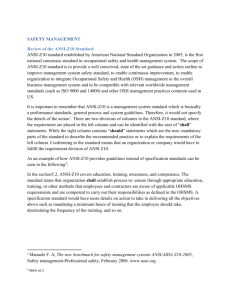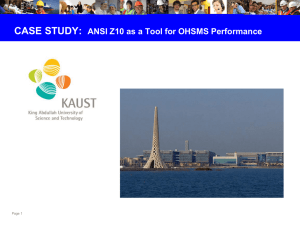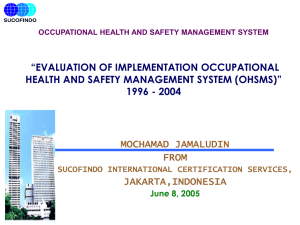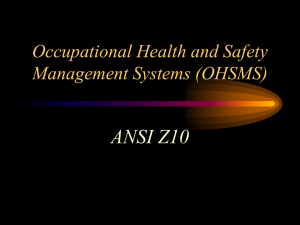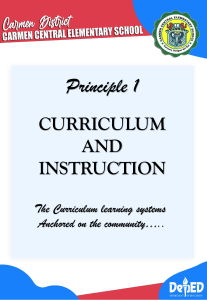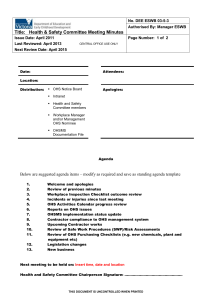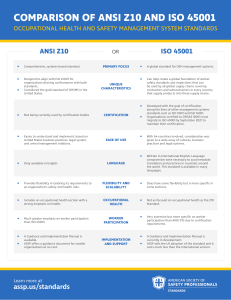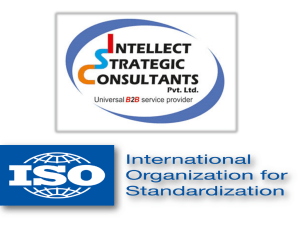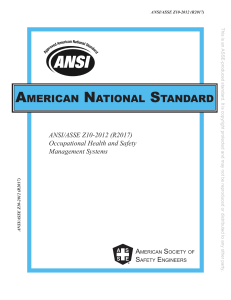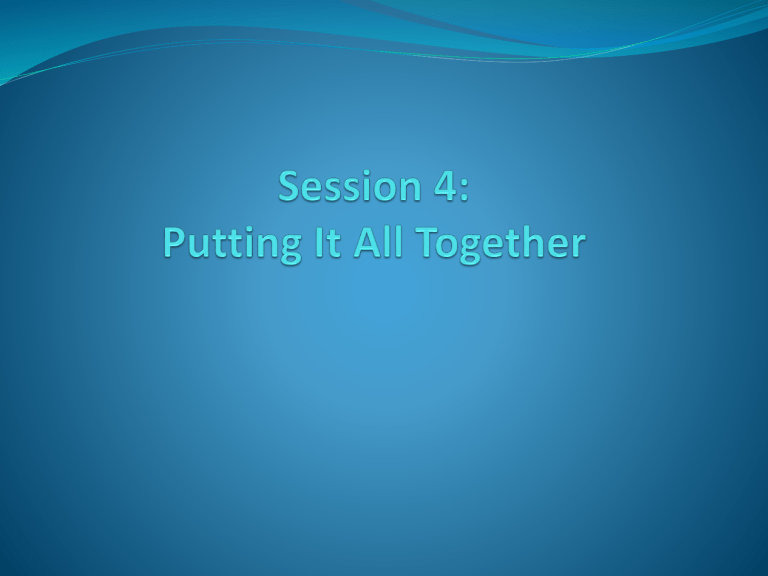
Disclaimer DISCLAIMER: This material was produced under grant number SH-19494-09-60-F-12 from the Occupational Safety and Health Administration, U.S. Department of Labor. It does not necessarily reflect the views or policies of the U.S. Department of Labor, nor does mention of trade names, commercial products, or organizations imply endorsement by the U.S. Government. The U.S. Government does not warrant or assume any legal liability or responsibility for the accuracy, completeness, or usefulness of any information, apparatus, product, or process disclosed. To this end, permission is granted to use such copyrighted material solely for noncommercial, instructional, personal, or scholarly purposes. The material may be used and incorporated into other workplace safety and health programs on the condition that no fee may be charged for the subsequent use of the material. Use of the material for any other purpose, particularly commercial use, without the prior, express written permission of the copyright owner/s is prohibited. Furthermore, any modification to the material is prohibited without the prior, express written permission of the copyright owners. Learning to Recognize Management System Elements On Thursday, May 15, 2008, a Contractor from International Valve and Instrument Corp suffered a heart attack within the waste-to-energy facility. While working on a boiler on the 9th Floor, the Contractor started to feel ill and called for help on the plant telephone. His call was heard throughout the plant and soon it became clear he was experiencing a heart attack. Immediately, Wheelabrator employees reacted to the emergency. By using an automated external defibrillator (AED) employees were able to stabilize him and monitor and administer treatment as needed, while waiting for the paramedics. Once help arrived, several employees assisted the paramedics in moving the gentleman from the 9th Floor to the 5th Floor where the elevator is located; CPR and shock treatment were administered several times throughout the process. The Contractor was transported by paramedics to a local hospital for further treatment. “I am extremely proud of the way all of our employees reacted. Everybody pitched in, did what we’ve all practiced and trained for,” Plant Manager Peter Kendrigan said. During 2003, new spinning frames were modified to allow access for maintenance technicians to perform routine and preventive maintenance to the overhead doffer mechanism. Since the original equipment design by the manufacturer provided no method of accessing process points for preventive maintenance on opening equipment at elevations of over ten feet, multiple platforms and ladders were installed in the opening process for the long and short staple nylon lines. Once these problems were identified, Alma employees on the Process Hazards Safety Committee completed the hazard and risk assessments and ultimately approved the upgraded equipment for production. This process involved identification of pinch points, hot/cold points, sharp edges, noise, dust and chemical hazards, and ergonomic handling opportunities. The Technicians now use a catwalk with guardrails to perform maintenance duties on equipment that is higher than eight feet off the floor. These platforms and ladders minimize the risk of falls from a life-threatening height. All new equipment has prestartup checklists. Since 2001, DM’s injury and illness rate have consistently been below the Bureau of Labor Statistic’s (BLS) national average for the industry. The Company’s Total Case Incident Rate between 2004 and 2006 was 1.13 (lower than their previous good performance of 1.49) which was 83 percent lower than the 2005 BLS national average. DM believes that not only is having an effective safety management system the right thing to do in terms of protecting its employees, but it is also the company’s best financial policy. Since 1999, when the company began its process towards achieving VPP approval and recognition, its worker’s compensation costs have decreased 96 percent. These savings results in overall profitability, and these profits are shared with employees who remain vigilant in pursuing safety in the form of performance bonuses. Strategies for Integrating ANSI Z10 The “Real Big” Picture Driving Forces Meet Expectations? Report How You’re Doing Check How You’re Doing Overcoming Barriers Initial Review/Priorities Work Plan for Objectives Develop OHS Framework Implement Framework Driving Forces: Macro Scale Number 1: A safe and healthy work environment Program efficiency and consistency Decreased liability Lower costs Greater employee empowerment Assurance to investors, insurance companies Continued focus on continual improvement Driving Forces: Micro Scale Positive: • Recognition • Lunches/Other Freebies • External Recognition Negative: • Fear of Failing Audit • Supervisors Get “Bad Report” Internally • Bad Performance Review OVERCOMING COMMON BARRIERS • Competing high-priority assignments • Need more time • Inadequate resources assigned • Uncertainty about organizational change • Lack of understanding • Lack of management/key staff support MANAGING ORGANIZATIONAL CHANGE Remember—People are involved! Develop buy-in Communication, training, status reports Try to understand expectations at all functional levels Before Diving In, Ask… What are our OHS priorities and concerns? What application does OHSMS have to these? What is our best-guess as to resource needs? What can we accomplish with internal resources? Where can we find additional resources? Assembling the OHSMS Team Not a one-person show Criteria for Team selection: Key facility operation areas People who will actively participate and support OHSMS Good attention to detail; ideally self motivators Management Sponsors Stakeholder Representatives (Union, ISO Auditors, etc.) Management/Employee Participation Top Management Core Team Implementation Teams Organize OHS Development Teams based on functional level: Top Management—Policy, Resource Assessment, Delegate Authority, Process for Management Reviews OHS Core Team—Initial Reviews, Implementation Plan, Framework Procedures Implementation Teams— Input to Initial Reviews, Development of Job Instructions for specific areas Initial Review Existing Business Processes You’re Probably Doing Most of the OHSMS Now! OHSMS elements build on existing practices OHSMS takes what is working and formalizes it into a system What are we doing now? What are you doing now as per ANSI Z10 to address OHS? Gaps? For the risks and objectives from Planning: What processes are in place for OSHA compliance? What processes might be used under ISO 9001 and/or 14001 (i.e., piggy-backed)? What voluntary initiatives exist? How do these processes meet ANSI Z10? How do they fall short? Action Plan What are we doing now? Some Compliance Elements to consider: Process Hazard Analysis Exposure Assessments Communications procedures (e.g., HazCom) Emergency Preparedness Training, Awareness and Competence Document and Records Management Periodic Reviews (e.g., LOTO) Safety Committee Meetings What are you doing now as per ANSI Z10 to address OHS? Gaps? What are we doing now? Some ISO 9001/14001 Elements to consider: Policy Objectives-setting Processes Communications procedures Emergency Preparedness Training, Awareness and Competence Document and Records Management Auditing Management Review What are you doing now as per ANSI Z10 to address OHS? Gaps? Initial Review: Risk Evaluation RISK UNDERSTANDING How likely is it? What can go wrong? What are impacts? Using historical knowledge, analytical methods and best judgment Severity of Injury or Illness Consequence Likelihood of Occurrence or Exposure Catastrophic Frequent High Critical Marginal Negligible Serious Medium Probable Occasional Remote Improbable Low Planning Phase Objectives The Basis for the OHSMS OBJECTIVES Results of risk analysis System Improvement OHSMS Policy Statements Strategic Business Plans Objectives Action Plans Action 1 – Name, Date, Objective – ISSUE medium to longterm improvement that will address any identified challenge or required improvement Target Project 1 Required Resources, Indicator Action 2 – Name, Date, Target Project 2 Required Resources, Indicator Action 3 – Name, Date, Target Project 3 Required Resources, Indicator Action Plans—Remember This Say What You Will Do, and Do What You Say! What you Say is the Action Plan What you Do must be monitored or measured If the Action Plan seems unmanageable, revise it! Objectives Performance CHEMICAL USE Objective – reduce level of exposure to toxic chemicals in the manufacturing and maintenance areas Project 1: Improve ventilation in welding Action 1 – Name, Date, Project 2: Eliminate chlorinated solvents Action 2 – Name, Date, Project 3: Reduce level of nuisance dust in gypsum storage area Action 3 – Name, Date, Required Resources, Indicator Required Resources, Indicator Required Resources, Indicator Objectives OHSMS Development OHSMS 5.1 Objective – develop and establish processes in conformance with Section 5.1 of ANSI Z10 Project 1: Process to ensure hierarchy of controls is considered Action 1 – Name, Date, Project 2: Improve existing management of change process Action 2 – Name, Date, Project 3: Process to review the health risks of purchased products Action 3 – Name, Date, Required Resources, Indicator Required Resources, Indicator Required Resources, Indicator Indicators of Progress What measure of progress might you choose to show progress of completion of the following: Installation of controls to reduce hexavalent chromium in a welding area Compliance with OSHA for newly chosen emergency response team Effectiveness of safety training program in achieving OHSMS Policy awareness Development of a Z10-conforming process for Procurement for acquiring chemicals Delivery of ANSI Z10 awareness training Department: Objective: Hazard Reduction/Other Benefit: Task Responsible Party Resources Implementation Plan Metric Target Finish Date Actual Finish Date Typical Implementation Process A new OHSMS Procedure is developed The new procedure is “rolled out” Tweaks to improve procedure, if needed Affected personnel get training in procedure Affected personnel get training reinforcement Records, other evidence of new procedure start to be generated Auditor finds several nonconformances, needs for improvement After some time (e.g., six months) an auditor reviews evidence Implement Plans: Likely Needs Implement action plans to fill gaps, objective: ANSI Z10 conformance Personnel training Good communications Document and record controls Monitoring and measuring progress Written operation/maintenance procedures Management of change Continued management review and support Did you notice? The process of developing and implementing Plans to put together a OHSMS Framework requires the same types of teamwork/elements as implementing the Framework itself (communications, procedures, review, documents, training, etc.) The process of developing an OHSMS can be thought of as the “first pass” through the “PlanDoCheckAct” cycle If you can put it all together (develop framework), you should be able to keep it all together (establish and maintain) Implementation: Remember this Keep it simple; go at the right pace Implement action plans to fill gaps, objective: ANSI Z10 conformance Stay within available resources Understand competence comes over time Ignorant bliss Conscious incompetence Unconscious competence Expect non-conformances As implementation improves, so will results Report and Improve! Management Review at least annually Recommendations for Improvement Specific inputs listed in Section 7.1 Management shall determine for OHSMS: Future direction Need for changes Thanks for your attention!
